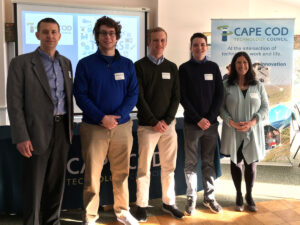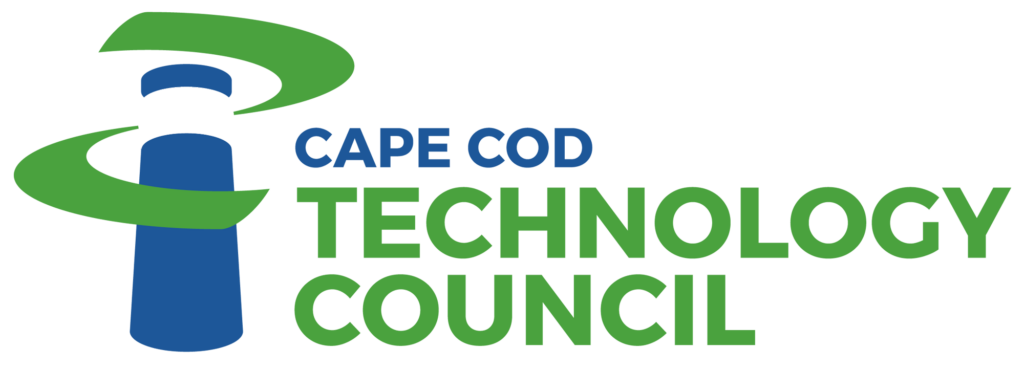
“The best argument against Democracy is a five-minute conversation with the average voter.”
This quote, attributed to Winston Churchill, inspired the 2018 winners of the Congressional App Challenge. Teen developers James Milinazzo, Matthew Nugent, and Michael Teevens of Pembroke High School came to the CCTC First Friday Breakfast Meeting to present their winning app, Get a Grip on Citizenship. The app, designed to solve decisionship problems, is based on the flashcard app Quizlet, and created with Android Studio and Java. Most of their time was spent learning Android Studio, after which they said the app took three or four weeks. The app is not available on the Google Play store yet.
Having taken all the classes offered at Pembroke High School, the three are now doing an independent study. Currently they’re working on making an app that’s similar to Tinder, helping people find an MMA (Mixed Martial Arts) sparring partner.
Dr. Ed Klein was our First Friday Speaker, bringing us up to speed on The Internet of Things (IoT).
Dr. Klein began by defining the IoT. There are two categories: Individual devices, and network of devices. Individual devices have low speed, high latency connectivity. In the network of devices, IoT overlaps with Artificial Intelligence. There is a school of machine-to-machine communication – fog communication (below the cloud) – that involves no human interaction. IoT is also big data and what you can do with it.
Sensors are the digital nervous system of resource constrained devices. They use gps, cameras, and microphones, and can also detect temperature and pressure changes (we heard of these sensors being put to use last year when Dr. Yuki Honjo discussed exploring the oceans). Tufts has even developed tooth mounted sensors that track what you eat, and Dr. Klein said there are ingestible devices that you consume.
IoT technology has even optimized what farmers do. An example of sensors in action is the Farmhand platform that allows farmers to automate functions and farm remotely. Freight Farms have full farms inside freight containers.
The Internet of Things has come a long way. Here’s the history, from Dr. Klein:
1969 internet emerges with ARPANET
1982 TCP/IP takes shape
1990 internet connected toaster – first common, connected device
1999 IoT gets its name
1999 M2M protocol is created
2000 we see the first IoT refrigerator
2005 UN recognizes IoT in an international Telecommunications Report
2010 Bluetooth Low Energy technology emerges
2011 Nest is created – IoT is now sensor driven, wifi enabled, and self-learning
In 2008 there were more devices connected to the internet than there are people in the world. One theme we see in IoT is the desire to control energy consumption – as evidenced by Nest.
As we tie more aspects of our lives (including utilities and healthcare) to IoT, the issue of security becomes the next hurdle on the timeline. The IoT Security Foundation’s mission is to make it safe to connect. Their motto is “build secure, buy secure, be secure.” Security needs to be part of the design from day one, with layers of security – like in larger computers but appropriate for IoT. For more on security, including best practices guidelines and other resources, visit iotsecurityfoundation.org
Dr. Klein noted that connected devices are shipped with one username and password. One big security hole is the number of people who don’t change those credentials before using their new devices.
Application of IoT is across the board. Here on Cape Cod we have the home automation company (and CCTC member) Savant. It’s also applied to healthcare, monitoring patients in the hospital and at home. IoT reduces readmissions and keeps patients happier and more comfortable, Dr Klein said. Furthermore, they’ve developed wearables for healthy people, to glean data and understand how better to fend off illness.
IoT is in buildings and businesses. The company Humanyze helps companies “make more informed people decisions,” using IoT data to understand how people interact, and improve flow and communication.
Cape Cod cranberry growers are using IoT to monitor and control conditions. Among other automations, temperature sensors trigger a series of mechanisms to protect the crops during a frost.
In 2017, the United States Government provided grant money for smart transportations. Boston’s grant proposal was a design to automatically reroute traffic. But it doesn’t stop with traffic. Chicago is developing a Smart City, partnering with Argonne National Laboratory on the Array of Things. There are 500 nodes in the city with environmental monitoring, air quality sensors, light and infrared sensors. All data is made public. Using the Waggle platform, they can provide a micro-climate view so you can see the air quality on your own block.
Where is IoT heading? Dr. Klein said one of the best signs is when the technology disappears, and that will be one of the successes of IoT. It’s growing quickly and has nowhere to go but up, he said. However, it’s also an area where we’ll see more hacking. Especially worrisome is the potential for large scale hacking, including the electrical grid, transportation, and hospital devices. He hopes to see more advances in the security space as privacy and security collide. He also hopes to see fragment industries coming together so they can work more efficiently.
Dr. Ed Klein, Ph.D., is the Manager of Data Center Services at Cape Cod Healthcare. He was previously an Engineering Manager and Scrum Master with Intel Corporation’s Internet of Things Group, developing software for embedded hardware and Intel’s Real-time Operating System
